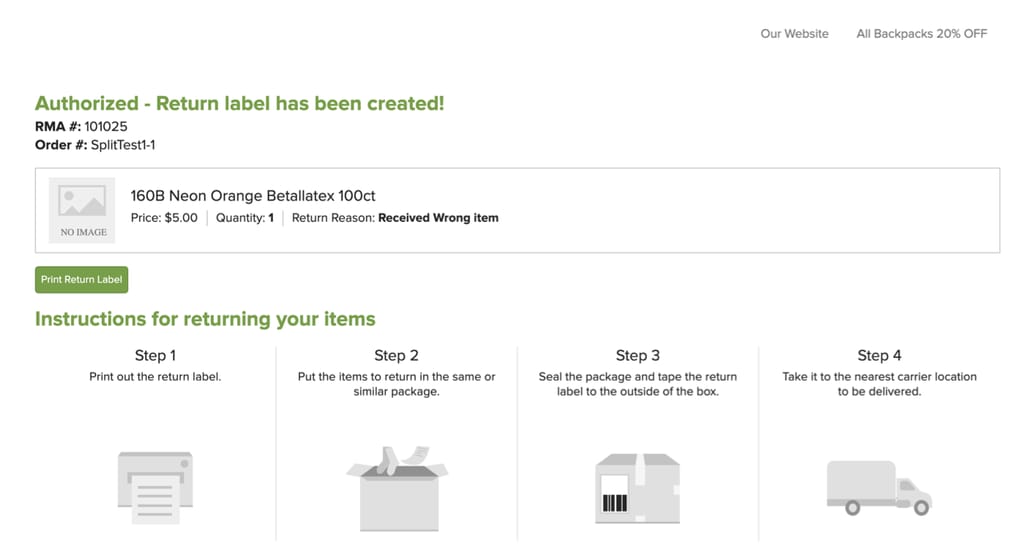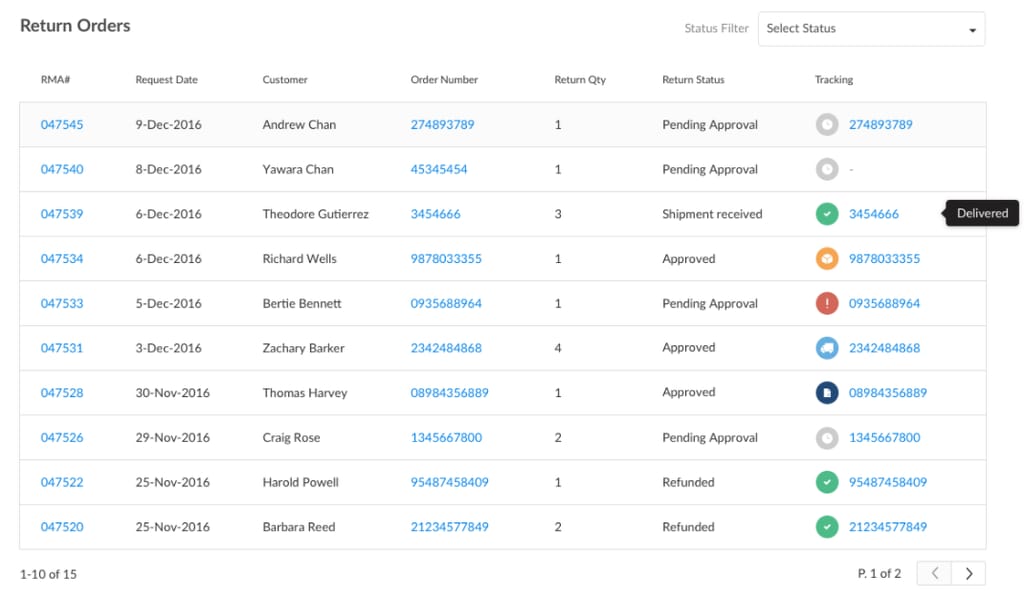The National Retail Federation estimated that in 2021 the total rate of returns was 16.6 percent, equivalent to around $761 billion in merchandise – and that’s in the US alone. In spite of associated losses, businesses can’t avoid giving customers the opportunity to return their purchases due to consumer law legislation. Besides, 79 percent of shoppers consider free returns an important factor when buying online, so it’s also about customer retention.
With returns being a necessary evil, the best you can do as a business owner is efficiently manage this process to reduce your losses – and that’s what we’re going to discuss in this article. So, what are returns management and reverse logistics, and how can software make it easier to handle that workload?
What is reverse logistics and returns management?
Reverse logistics is basically the opposite of normal supply chain operations, meaning that goods move back from the consumer or distributor to the seller or manufacturer. It doesn’t only refer to the return of purchased or unsold goods, but also, for example, sending empty pallets, containers, or other packaging materials back for reuse.
Returns management – the main component of reverse logistics – is a set of activities aimed at arranging and controlling the reverse flow of goods. Some sources associate the concept only with handling returned items, while others use it in a broader sense and include repairs, refurbishment, recycling, etc. We, for the sake of generalization, will adopt the latter approach.
The goal of returns management is to either get returned inventory back to the supply chain to regain value or dispose of it in the most efficient way.
Now that we’ve explained the main terms, let’s look closer at how reverse logistics works.
Reverse logistics process
As we said, reverse logistics moves goods in the opposite direction along the supply chain. This movement can start from the end-customer, retailer, wholesaler, or even manufacturer who wants to return raw materials or other inventory to the supplier. Depending on the business, the process would differ, but here are the main stages.
Main stages of reverse logistics process
Initialization. A consumer initializes and requests a return from the supplier. Reasons are many: customers can change their mind, products might not work or not fit the description, packaging return is part of the contract, and so on.
Processing. The supplier processes the return and decides which action to take. Typically, companies create a return policy to define how exactly they handle returns (B2C) or include a relevant section in a contract (B2B).
Shipping. In case return is approved, the goods are shipped back to the supplier. While B2B scenarios might differ, in the B2C model, transportation is usually arranged by the retailer with customers having a choice of drop-off options.
Inspection. The supplier receives returned inventory and inspects it.
Action. At the final stage, there are a variety of options. Returned items can be repaired and sent back, restocked for reuse or resale, recycled, or liquidated. Exchange, store credit, or refund can be offered if applicable.
Cost of reverse logistics and related opportunities
Returns are usually thought of as pricey and, obviously, unwanted. Costs associated with reverse logistics include
- transportation expenses (to deliver items, to send them back, and in case of exchange, to redeliver);
- repair costs;
- labor payments for processing returns, quality testing, restocking, etc.;
- holding costs in case of restocking, and so on.
However, it’s not only about extra expenses. If you handle your returns wisely, you can regain their value (at least partially). Other benefits of effective returns management would be faster service and turnover, customer retention, increased sustainability, and reduced losses.
If you are a retailer and rely on a 3PL or fulfillment service provider to manage your logistics operations, they probably handle returns for you. But if you are a 3PL company or run your supply chain yourself, even forward logistics is often tough, and reverse logistics can turn into quite a pain in the neck. It has to be seamlessly embedded into your transportation and warehousing operations. Let’s explore how technology can help here.
Returns management software: main features
As we said, managing returns entails a bunch of challenges, including
- communication with customers,
- creating and maintaining return policies which can be different for separate products or product categories,
- arranging transportation,
- tracking the movement of returned inventory along the supply chain,
- coordinating refunds, credits, or product exchanges,
- analyzing the value and impact of returns on the company’s bottom line, and so on.
If you sell postcards or flower seeds to your neighbors, you can definitely deal with all that manually. Any business larger than that will get swamped with paperwork and end up messing up orders, refunds, and warranties.
Good news: Today, there are a lot of software solutions on the market that can help you out. Well, okay, you can’t automate the entire process (like you still need homo sapiens to inspect returned items and click those approve or disapprove buttons), but technology can bring some kind of order into this mess and help you cope with your reverse flow of goods.
Some of these tools are specifically designed to solve the needs of, say, eCommerce vendors (e.g., Return Rabbit or ReturnLogic), while others are more comprehensive and can be used by 3PL companies, wholesalers, or manufacturers (e.g., ReverseLogix). Here are some common features of such platforms.
Customer portal
A user-friendly customer self-service platform is crucial for efficient communication. Of course, this feature will be most useful for B2C companies to give shoppers a convenient opportunity to initialize and manage the return process.
Once the customer requests a return, the system approves or rejects it according to your return policy. It’s called the Return Merchandise Authorization (RMA) process. If the items are eligible for return, such portals allow customers to choose the most suitable drop-off and shipping method (e.g., in-store drop-offs, via mail or carrier office, scheduled carrier pickups, etc.), print the shipping label, request exchanges or refunds, and indicate the reason for return.
An example of an intuitive, easy-to-use customer portal. Source: ShipStation
There are a lot of benefits such a self-service platform holds. You can reduce the number of returns by adding an exchange option and encouraging your customers to go with it. Also, if you put some effort into customizing your portal with personalized messages, as well as your logo, colors, and other design elements, it can become a great marketing tool that supports brand awareness. And a smooth return experience will increase loyalty and retention.
Tip: Another option is creating a chatbot and adding it to your website or app to enhance your customer support and help desk. Users can conveniently interact with the bot to get answers and manage their returns.
Shipping and tracking
A returns management platform should be able to generate labels and other shipping documentation to provide to customers in compliance with carrier standards.
On the internal side, it has to automatically generate the RMA number (it’s needed for tracking purposes) and assign the warehouse or DC where the shipment has to be delivered.
Tracking returns status. Source: AfterShip
If you work with external carriers and have your systems properly integrated (more about it in the next section), your returns management tool should pass the pickup and shipping details to your delivery partners and allow you to track transportation progress.
You might also need the support of international returns. Obviously, it’s an even bigger hassle, but software can help you handle multi-currency refunds and the creation of all the necessary documentation (shipping labels, customs documents, tax forms, etc.).
Barcode scanner functionality
Once your team receives the returned items, barcode scanning is an easy way to get the product details, log them in the system, adjust order status, and update stock levels. No network required, fast and simple.
Support for a variety of order flows
As we said, all businesses are different. You can be a manufacturer working with hundreds of raw material suppliers or a special niche retailer selling from one wholesale vendor or maybe you are an online store working on a dropshipping model… Good returns management software should be able to support any kind of workflow you might be operating on.
You should be able to choose who pays the transportation and processing fees. Also, software has to account for such scenarios as repairs (in-house or external), in-store returns, shipping to the original supplier (in this case you would have to initialize the return process), liquidation (with a range of options), restocking, and so on. The same with refund and credit – you should have a broad choice of possible follow-up actions, both to request and issue the compensation.
Big companies like Amazon, Target, or Walmart sometimes even issue a refund without having the product back – for example, if the product is damaged and it’s just not worth shipping it. And that’s yet another scenario that should be supported by the system.
Reporting and analytics
Collecting and analyzing business data is essential to have a complete understanding of your company performance and to support a data-based approach to management. We have a separate post dedicated to supply chain analytics that you can check out. Talking about returns, here are a number of aspects that are crucial to assess:
- reasons for returns,
- number/percentage of reverse shipments,
- value of returns and costs breakdown,
- regained value from reselling, refurbishment, etc.,
- customer satisfaction with your returns process, and so on.
As you can see, it’s not only about monitoring financial results, but also about receiving and analyzing direct consumer feedback. You have to know what your customers think to provide them better service, adjust your inventory assortment, control the quality of the items you sell, check their descriptions, and more. So, it’s important to have a robust analytical module with a variety of reports and practical dashboards.
Another vital aspect of implementing returns management software that needs to be discussed is its integration with other systems.
Returns management software integrations
We often emphasize the importance of building connections between internal and external systems. In the case of returns management, it’s an absolute must since that’s pretty much what efficient automation is about. We’ve already described how complicated this process is, and without seamless data exchange, it’s pretty much doomed to fail.
Many ready-made software solutions offer out-of-the-box integrations with the following systems.
Inventory management systems (e.g., Orderhive, Zoho Inventory) and/or warehouse management systems (e.g., Fishbowl, 3PLCentral) – to automatically update stock levels, easily handle replacements, and assign the right storage locations;
ERP/retail management/order management systems (e.g., Oracle, SAP, Odoo, Brightpearl) – to share product/order details and update inventory amounts;
eCommerce platforms (e.g., Magento, Shopify) and marketplaces (e.g., Amazon, eBay) – to get access to order information and product catalogs, facilitate replacements, and update stock;
Point of sale (POS) systems (e.g., Lightspeed, Revel) – to manage refunds in brick-and-mortar stores;
Accounting software (e.g., QuickBooks, Xero) – to share financial data, issue refunds, evaluate expenses, and accurately work out the bottom line;
CRM software (e.g., Salesforce, HubSpot) – to collect customer information and monitor so-called serial returners (shoppers who take advantage of the free returns policy and overuse the opportunity causing losses);
Business intelligence tools (e.g., Tableau, Microsoft Power BI) – to gather and analyze returns-related data to gain actionable insights and support business decisions;
Customer support tools (e.g., LiveAgent, Kustomer) – to allow your support team easily retrieve all the order and customer details and be able to provide efficient assistance;
Liquidation or refurbishment platforms (e.g., B-Stock, Back Market) – to exchange information about products meant for reselling on such marketplaces or auctions;
Transportation management systems (e.g., 3GTMS, Blue Yonder) – to support your logistics operations if you have your own fleet;
3PL or fulfillment companies (e.g., ShipBob, ShipHero) and/or shipping providers (e.g., DHL, UPS, FedEx) – to facilitate data exchange with carriers who deliver your products.
Why integrate returns management software with other systems
Which integrations you need – depends on your business model and existing systems. As a rule of thumb, connecting to the IMS/WMS is essential so that inventory levels are automatically updated when items are returned and replacements are issued. Plus, integration with preferred carriers is usually unavoidable to accurately generate shipping documentation, arrange pickup and transportation, and track reverse shipments.
When choosing a platform to manage returns, check available integrations and whether it’s enough for your needs.
If the systems you use are not on the list (or you need to integrate, say, with a wholesaler’s custom platform), you’ll have to build bespoke connections yourself so make sure open APIs are available. Note that in this case, it will take additional investment plus time and involvement of experienced IT professionals.
Returns management software implementation: main approaches
It’s hard to give recommendations since all businesses have different needs. Moreover, you can start off as a small eCommerce store and then grow to an omnichannel enterprise – requirements would change as you scale and that’s what you have to consider when building your technological ecosystem. Anyway, basically, you have three options.
You can use the returns management module of a more comprehensive platform. Most logistics, retail, eCommerce, inventory, and other specialized, multi-featured systems have the capabilities that allow you to handle reverse logistics. The good thing about it is that you’ll have all the information in one system; however, the functionality might be limited and not fit your business requirements.
You can acquire a standalone solution. In case you need more than a built-in module can offer, you can explore the market and try to find the right tool that will work better. Remember that in this case you’ll have to connect it to other internal and external systems you work with to establish a smooth data exchange.
You can develop a custom product. If you have a unique business flow, consider building a bespoke module that will seamlessly fit into your existing IT environment. Creating custom functionality is more time- and resource-consuming than implementing a ready-made solution, but it would allow you to efficiently tackle uncommon business challenges and fully streamline your reverse logistics operations.
Returns management success stories
We understand that to business people facts and numbers are the most convincing argument. Here are just a few stories of how software implementation addressed common difficulties and increased performance.
An apparel brand increases efficiency by 900 percent
At some point, JOLYN, a swim and activewear brand, found itself flooded with returns-related emails, messages, and support tickets. It took up to 2 weeks to complete RMAs which caused customer and employee frustration.
After implementing a returns management solution, they managed to reduce their RMA processing time to about 1.5 days, making their shoppers happier and having their products restocked a lot faster. In addition, they gained greater operational visibility and reduced their refund requests by 10 percent.
A European design company reduces staffing costs
Royal Design Group is a huge Scandinavian eCommerce company that offers design and home furnishings. As they scaled their business, they realized that they couldn’t cope with the increased amount of returns and deliver a good customer experience.
As they digitized their returns process, the handling time significantly reduced which allowed them to lower staff costs at the customer service department by 31 percent. With the help of smart return rules, they can create incentives for fewer unnecessary returns, and access to data helps further improve customer experience and their products.
They also noticed that warehouse operations were optimized. Site Manager, David Måsegård reports: “We can follow the return process before the returns have arrived at the warehouse but also whilst the returns are being handled at the warehouse. This gives us the possibility to proactively work with resource management between the warehouse and returns department.”
Online marketplace maximizes recovery
A home remodeling and design marketplace was struggling with the manual returns process and space limitations. They were donating and disposing of returned items, not regaining any value.
Due to their partnership with a reverse logistics company, among other gains, they managed to resell 91 percent of their returns via the recommerce market. That increased net recovery (vs. cost) by more than 150 percent.
Global sport company processes twice as many returns as before
Amer Sport, a sporting goods company with world famous brands such as Wilson and Solomon, was experiencing difficulties processing hundreds of thousands of returned units after shifting from solely working B2B to B2C model.
A specialized return solution allowed them to streamline and expedite their operations, doubling the amount of returns they can process. Scott Allington, an Inbound and Return Goods Supervisor, rejoices: “It’s kind of a one-stop-shop for us; it’s taking care of all the backside stuff that we had to do manually before, so it’s definitely been a time-saver.”
They also noticed how the call volume reduced and how their customer experience improved. More transparency, easy tracking, simple operation, and fast training are other reasons Amer employees are happy with the new digital returns tool.
Groove Life serves 50 percent more customers
Groove Life produces silicone rings, bands, belts and other products for adventurers. They realized that responding to return requests via email or phone wasn’t efficient, so they found a software platform to automate their reverse logistics processes.
As a result of implementing a customer self-service portal, they could process 500-600 more return requests daily (vs around 1000 that could be done before). They also collect data and customer feedback that gives them valuable insights into shoppers' demand and their product quality.

Maria is a curious researcher, passionate about discovering how technologies change the world. She started her career in logistics but has dedicated the last five years to exploring travel tech, large travel businesses, and product management best practices.
Want to write an article for our blog? Read our requirements and guidelines to become a contributor.

